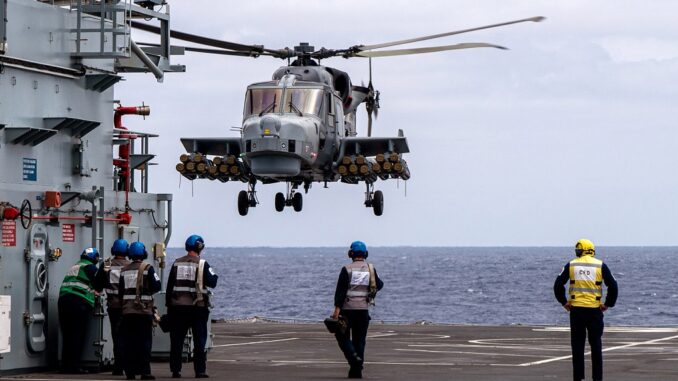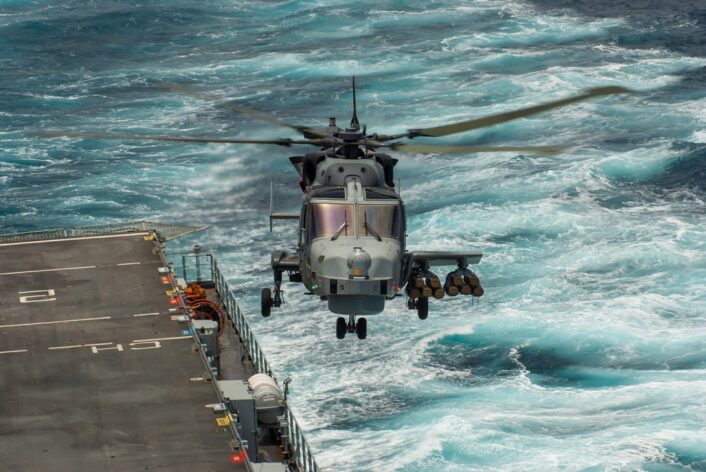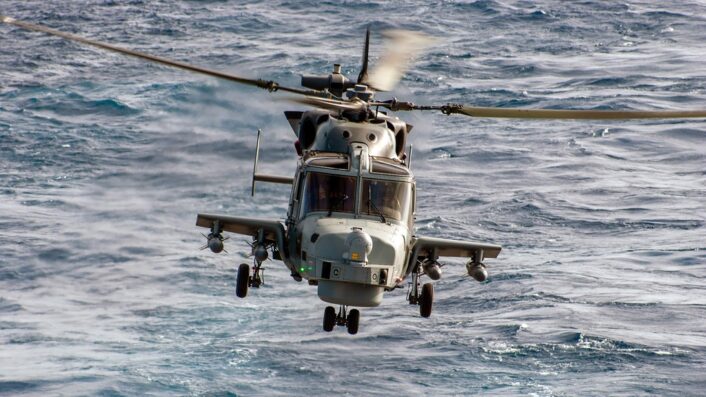[ad_1]

The Royal Navy helicopter has been extensively tested in various configurations, including a heavy 20-missile load.
The Royal Navy’s AW159 Wildcat helicopters completed a new round of trials with the Martlet and Sea Venom air-to-surface missiles. The month-long campaign saw the helicopter operating from RFA Argus in the Atlantic and Mediterranean over a month, from where a specially instrumented Wildcat HMA was flown on 19 days for a total of 87 flight hours and conducted 894 deck take-offs and landings, by day and night.
The Royal Navy says the trials will help write the manual for using the weapon in various weather and sea conditions, allowing Fleet Air Arm aviators to take out small and large threats to the Fleet. RFA Argus sailed more than 8,000 miles in the Atlantic, mostly between the Canary Islands and Cape Verde, and then into the Mediterranean, chasing different weather conditions.
The presence of the missiles on the ‘weapon wings’ affects the way the helicopter handles so, in order to determine the boundaries for safe flying – known as Ship Helicopter Operating Limits – the helicopter had to be tested in presence of the myriad conditions that could have an impact on the performance: wind speed, direction and air flow over the deck, humidity, temperature, the sea state, pitch and roll of the deck, as well as the weight and configuration of the aircraft itself.
From initial results, the Royal Navy says the trials exceeded expectations as the Wildcat operated with weapons loads in seven different configurations, including asymmetric loads, with the helicopter on occasions loaded up to more than six tonnes. Once analysed, the data will guide air/ground crew in operating a Martlet/Sea Venom-armed Wildcat on frigates, destroyers, auxiliaries and Queen Elizabeth-class carriers.
Martlet and Sea Venom are the two variants of the Future Anti-Surface Guided Weapon (FASGW) programme, the latest air launched weapons of the Royal Navy. Defence Equipment & Support (DE&S) is integrating them on the Wildcat Helicopter Maritime Attack (HMA) Mk.2, with the first successful test firing of Martlet carried out during the maiden deployment of the Carrier Strike Group last year.

This summer, the Wildcat launched two Martlet missiles air-to-surface missiles into the ex-USS Boone’s hull during Atlantic Thunder 2022. This was the first firing of the Fleet Air Arm’s new anti-ship weapon against a realistic target at sea – to this point Martlet had only been used against purpose-built targets. Now that testing on the RFA Argus has been completed, the Royal Navy says the weapon is ready for the frontlines.
The short-range Martlet missile, also known as the Lightweight Multirole Missile, is an air-to-surface and surface-to-surface supersonic missile for use against small surface vessels, which offers a unique capability to defeat asymmetrical and terrorist threats in the littoral environment. The Wildcat can fly with up to 20 Martlet missiles, as each of them only weighs 13 kg (but can still provide an engagement range of more than 6 km).
The larger Sea Venom is twice the size of Martlet, has more than double the range and is fitted with a 30kg charge. Each Wildcat can carry up to four – or a combination of Sea Venom and Martlets. Sea Venom is being developed also for the French Navy, which calls it Anti-Navire Léger (ANL). The missile is intended to knock out patrol craft and seriously damage larger vessels and, like Martlet, was also deployed during CSG21.
Sea Venom, like most anti-ship missiles, uses sea-skimming technology that makes for enemy ships much harder to intercept the incoming missile. Sea Venom can engage multiple targets at the same time and the man-in-the-loop feature allows to easily switch between targets even after the missile is launched from the helicopter, according to MBDA.

[ad_2]
Source link
